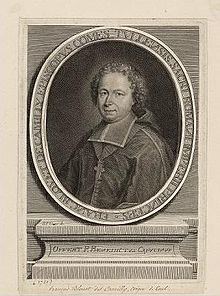 | ||
Jean-François Cars (16 October 1661, Lyon, France – 30 August 1738, Paris, France), was a French engraver, printer, publisher and printseller from Lyon.
Contents
Biography
Jean-François Cars was born in Lyons on 16 October 1661, the son of François Cars père [Senior], and his wife, Virginie Chesne. His father was an engraver and printseller who had come from Paris to settle in Lyon, at rue [Street] Mercière, with his brother, Gabriel, also an engraver. They were the sons of Jean Cars, an artisan and a sculptor “de peu de notoriété” [“of little notoriety”] of Paris, and his wife, Maria Firans, the daughter of an engraver. So Jean-François and his brothers, François fils [Junior] (1682—1763) and Joseph, were the fourth generation of engravers in their family. Baptized on the next day, Jean-François had as his godfather another engraver, François Demasso of Lyon, who also worked as a merchant of prints and figurines.
Jean-François learned his craft in the workshop of his father, as well as from the maker of intaglios, Pierre Husson (1675–1676), and the printer of intaglios, Chabrilland. However, his earliest prints by hand dated only from 1693, when, in the wake of his father, he provided the plates for the illustrations of the works being published in Lyon.
On 18 October 1695 in Lyon, Jean-François married a Parisian, Marie Barbery, the sister of the engraver Louis Barbery. They had seven children, including Laurent Cars and a daughter, Agatha, who married the King’s printer Gabriel-François Quillau. The family lived with François Cars at first and then settled, under their own sign, “A Saint-Hubert”, at rue Mercière, in 1698. At this shop, Jean-François engraved portraits of local notables as well as vignettes for the works that were being published in Lyon. He also engraved the titles and frontispieces of the books for the libraries of Lyon.
He had several presses and employed several Lyonnaise engravers, including Claude Séraucourt and especially his own brother, François Cars fils.
Jean-François moved to Paris at the beginning of the 18th century, followed by his younger brother, François. However, for nearly ten years, the brothers stayed active in both cities. In Paris, Jean-François had had his shop at rue de la Savonnerie since 1702 yet his youngest son was born in Lyon in December 1704. In 1711, he extended his lease of the Lyonnaise home for five years. In 1720, he bought his own Parisian house at rue Saint-Jacques, where he had already been renting since 1712. It was adjacent to either the Sorbonne or the Collège du Plessis. He changed his shop’s sign to “Au Nom de Jésus” [Latin, “At the Name of Jesus”], and, in 1726, he expanded his shop to a bigger building, probably to move his operations. He continued not only to make engravings (an activity he gradually abandoned) but also work as a publisher and seller of prints. He specialized, among other things, the placards for the theses for the Jesuit colleges, especially the ones in Paris and Bordeaux.
Jean-François kept a workshop where many apprentices, especially François Boucher and Jean-Baptiste Perronneau learned and worked; in 1730, it had six presses for making the intaglios. But he also found the time to serve his parish church, Church of Saint-Benoît-le-Bétourné, just down the street from his house, as a commissioner of the poor and a churchwarden.
Jean-François died on 30 August 1738 at his home on rue Saint-Jacques in Paris. He was buried on the next day at the Church of Saint-Benoît-le-Bétourné.
Engravings
The works of Jean-François Cars are not considered to be equal of those of his more famous son, Laurent Cars. His plates are sometimes marked “J. F. Cars” but more frequently “J. F. Cars fils [Junior]”. He is known to have engraved the portraits of the following notables:
